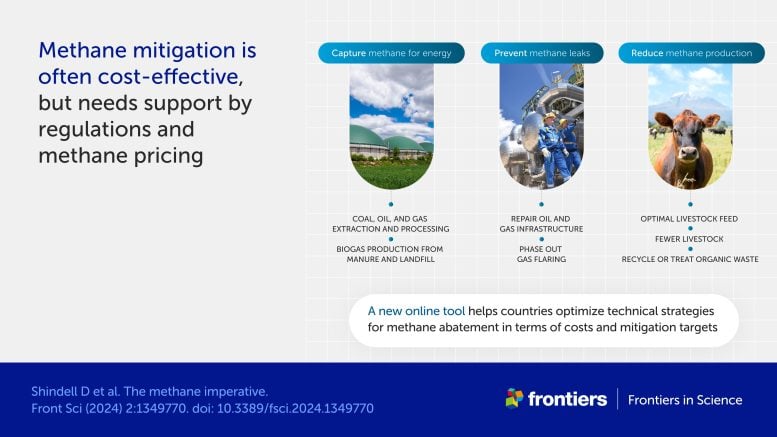
Methane, the second most important greenhouse gas, has been neglected—but now scientists lay out a new plan and a new tool to cut emissions down to size.
Researchers stress the importance of swiftly reducing methane emissions to address climate change, suggesting a mix of regulatory and economic strategies alongside public action to curb emissions from multiple sources.
Methane’s Role in Climate Change
To address the climate crisis effectively, immediate action on methane emissions is essential. Methane has contributed about half the global warming we’ve experienced so far, and emissions are climbing rapidly. An international team of climate researchers writing today (July 30) in Frontiers in Science set out three imperatives to cut methane emissions and share a new tool to help us find the most cost-effective ways of doing so.
“The world has been rightly focused on carbon dioxide, which is the largest driver of climate change to date,” said Professor Drew Shindell of Duke University, lead author. “Methane seemed like something we could leave for later, but the world has warmed very rapidly over the past couple of decades, while we’ve failed to reduce our CO2 emissions. So that leaves us more desperate for ways to reduce the rate of warming rapidly, which methane can do.”
Strategic Approaches to Cutting Methane Emissions
Methane is the second most potent greenhouse gas, but only about 2% of global climate finance goes towards cutting methane emissions. These emissions are also rising fast, due to a combination of emissions from fossil fuel production and increased emissions from wetlands, driven by the climate crisis. To slow the damage from climate change and make it possible to keep global warming below 2°C, we need to act immediately, following the Global Methane Pledge to reduce methane emissions by 30% from their 2020 level by 2030.

The scientists lay out three critical imperatives for action, backed by analyses of satellite remote sensing data, reported methane emissions, and the interaction of abatement options with market forces. Firstly, we need to bring methane emissions down. Secondly, we need to coordinate efforts to tackle methane and carbon dioxide emissions—only cutting carbon dioxide won’t stop warming quickly enough, but only cutting methane just delays global heating. Thirdly, we need to incentivize and enforce methane abatement.
Economic and Health Implications of Methane
This is a life-saving, cost-effective measure. Estimates indicate that every tonne of methane emitted in 2020 caused US$470-1700 of damages. But this may be a significant underestimate: taking into consideration the effect on air pollution that damages human health, the true cost could be up to $7,000 per tonne—and rising.
“The benefits of methane mitigation nearly always outweigh the net costs,” explained Shindell. “Many methane mitigation options provide net economic gains even without accounting for environmental impacts.”

Long-term Impact and Mitigation Strategies
Methane doesn’t accumulate in the atmosphere in the long term, so emissions reductions take effect more quickly. If we could cut all methane emissions tomorrow, in 30 years more than 90% of accumulated methane—but only around 25% of carbon dioxide—would have left the atmosphere.
“The most important mitigations are the available mitigation options across all sectors that aren’t too expensive, because we really need to do everything to reach climate targets such as 1.5 or 2C warming,” said Shindell. “Controlling methane from only one sector wouldn’t be enough. We need a broad portfolio of actions.”
Tools and Tactics for Effective Methane Management
The most impactful opportunities to fight methane will depend on the measures a country has already taken and the industries it relies on. So the authors created an online tool to identify the most effective measures for abatement in different countries. For big fossil fuel producers, regulating production, incentivizing the capture of methane, or charging companies for methane emissions could be the most effective options. For others, focusing on emissions from landfills could offer the biggest rewards. Individuals can help by making lifestyle changes and by thinking about the environment when they vote.
“People can make sure they avoid overconsumption of beef and dairy, and compost their organic waste whenever possible,” said Shindell. “If it’s not possible where they live, they can vote for those who’ll create programs for composting in their towns. They can also vote for those who will make polluters pay for methane emission rather than letting them profit while society picks up the tab for the damages they’re inflicting.”
Challenges and the Path Forward
“There are uncertainties, of course,” cautioned Shindell. “We don’t yet have enough data to fully parse out the contributions of individual factors to the recent surge in the observed growth rate, for example. But it is imperative to rapidly reduce methane emissions to reduce the accelerating climate damages so many people around the world are suffering.”
Reference: “The methane imperative” by Drew Shindell, Pankaj Sadavarte, Ilse Aben, Tomás de Oliveira Bredariol, Gabrielle Dreyfus, Lena Höglund-Isaksson, Benjamin Poulter, Marielle Saunois, Gavin A. Schmidt, Sophie Szopa, Kendra Rentz, Luke Parsons, Zhen Qu, Gregory Faluvegi and Joannes D. Maasakkers, 6 June 2024, Frontiers in Science.
DOI: 10.3389/fsci.2024.1349770
7 Comments
“Scientists”…
Whoever thinks that a hypercomplex ecosystem, such as our atmosphere, can be wholly driven up or down by increments in a single variable, is no scientist but a common hack.
If you will pardon the pun, the article is gaslighting:
https://wattsupwiththat.com/2023/03/06/the-misguided-crusade-to-reduce-anthropogenic-methane-emissions/
They recommend composting. However, composting produces carbon dioxide AND methane, which turns into carbon dioxide quickly, which is why methane has such a short lifespan.
It is disingenuous to pretend that water vapor isn’t a greenhouse gas. It is usually dismissed with the rationalization that it precipitates out in a few days. [The Global Warming Potential of gases is naively defined as the radiative warming for a pulse of gas, integrated over time — usually 100-years.] However, atmospheric water vapor is continually renewed by evaporation and transpiration, typically maintaining a nearly constant regional concentration over time! Furthermore, humans are injecting more into the atmosphere through dam building, irrigation (especially pivotal irrigation) in arid regions, and the burning of fossil fuels. Warming increases the potential for holding more water vapor in the atmosphere.
And as if the above isn’t sufficiently myopic, there are efforts to reintroduce beavers into former habitats. Beavers create wetlands, which produce methane.
When my wife first suggested that dark matter might be causing climate change I laughed. Dark matter after all should be a constant, I thought. When we began looking at the data I stopped laughing. Dark matter it seems is not a constant.
Global Warming is happening but dark matter is the chicken and Co2 is the egg.
Dark matter phase transitions appear to be a primary climate driver. If the solar system passes through an area of higher liquid dark matter content the planets cores would all receive more heat due to increased phase transitions thus heating the earth from the inside out.
Heating of the planet from the inside out would result in :
Increased ground temperatures
Increased sea temperatures
Increased nighttime temperatures
Increased volcanic activity
Increased earthquakes
We are currently passing through the S1 dark Matter stream which, as it is going the opposite direction around the galaxy was described as a dark matter hurricane. From spring to fall the earth is downstream from the sun. And from July to December the earth is traveling with the S1 stream and from January to June we get our maximum ongoing dark matter exposure as we travel into the S1stream. It would be interesting to see if the upper atmosphere temperatures are lower in the spring than the fall due to more incoming dark matter. There have also been peer reviewed papers that discuss dark matter annihilation(or in my hypothesis phase transition)heating the earth from the inside, they did not mention any impact to climate change or the S1 dark matter stream.
It’s easy to pin blame onto something no one is certain even exist. So you can’t be disproven. But you can’t be proven right, either.
An online search for “S1 dark Matter stream” produced no hits! I have not heard the term “S1 stream” before. Is it something that you made up, or can you provide a reference to the peer reviewed papers you allude to?
If methane is a fuel we should mine the atmosphere for it.
I always wondered why lightning and forest fires never burnt it all off, willothewisp?
Methane does readily oxidize, which is one of the reasons that it has such a short lifespan. However, when the atmospheric concentration is less than 2 parts per million, there isn’t enough to support a flame. “Mining” the atmosphere for it would be energy intensive. It would take much more energy to extract, concentrate, purify, and distribute it than it would give back as usable energy.